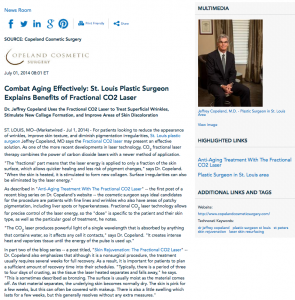Combat Aging Effectively: St. Louis Plastic Surgeon Explains Benefits of Fractional CO2 Laser

Dr. Jeffrey Copeland uses the Fractional CO2 laser to treat superficial wrinkles, stimulate new collage formation, and improve areas of skin discoloration.
St. Louis, MO – For patients looking to reduce the appearance of wrinkles, improve skin texture, and diminish pigmentation irregularities, St. Louis plastic surgeon Jeffrey Copeland, MD says the Fractional CO2 laser may present an effective solution. As one of the more recent developments in laser technology, CO2 fractional laser therapy combines the power of carbon dioxide lasers with a newer method of application.
“The ‘fractional’ part means that the laser energy is applied to only a fraction of the skin surface, which allows quicker healing and less risk of pigment changes,” says Dr. Copeland. “When the skin is heated, it is stimulated to form new collagen. Surface irregularities can also be eliminated by the laser energy.”
As described in “Anti-Aging Treatment With The Fractional CO2 Laser” – the first post of a recent blog series on Dr. Copeland’s website – the cosmetic surgeon says ideal candidates for the procedure are patients with fine lines and wrinkles who also have areas of patchy pigmentation, including liver spots or hyperkeratoses. Fractional CO2 laser technology allows for precise control of the laser energy, so the “dose” is specific to the patient and their skin type, as well as the particular goal of treatment, he notes.
“The CO2laser produces powerful light of a single wavelength that is absorbed by anything that contains water, so it affects any cell it contacts,” says Dr. Copeland. “It creates intense heat and vaporizes tissue until the energy of the pulse is used up.”
In part two of the blog series – a post titled, “Skin Rejuvenation: The Fractional CO2 Laser” – Dr. Copeland also emphasizes that although it is a nonsurgical procedure, the treatment usually requires several weeks for full recovery. As a result, it is important for patients to plan a sufficient amount of recovery time into their schedules. “Typically, there is a period of three to four days of crusting, as the tissue the laser heated separates and falls away,” he says. “This is sometimes described as bronzing. The surface is usually moist as the material comes off. As that material separates, the underlying skin becomes normally dry. The skin is pink for a few weeks, but this can often be covered with makeup. There is also a little swelling which lasts for a few weeks, but this generally resolves without any extra measures.”
For patients interested in the procedure, Dr. Copeland advises the importance of seeking a surgeon who has experience with the laser, and a practice where safe measures are followed regarding protection from potential complications. Ultimately, the CO2 fractional laser therapy allows for effective, controlled, and safe – but fairly aggressive improvement of the quality of the skin surface, he says.
About Jeffrey Copeland, M.D.
Dr. Copeland earned his medical degree from the University of Missouri-Columbia, where he also completed his residencies in general and plastic surgery and a fellowship in microvascular surgery. He has over 26 years experience as a cosmetic surgeon and is certified by the American Board of Plastic Surgery. Dr. Copeland is a member of the American Medical Association, and he currently serves as President of the Missouri State Medical Association. Dr. Copeland was previously chief of staff at St. Joseph Health Center and Barnes Jewish St. Peters Hospital, and he served as past board chairman of Primaris (the Missouri Quality Improvement Organization). He is available for interview upon request.
For more information about Copeland Cosmetic Surgery, please visit: copelandcosmeticsurgery.com and facebook.com/copelandcosmeticsurgery.
Contact:
Copeland Cosmetic Surgery
#2 Richmond Center Court
St. Peters, MO 63376
(866) 377-0288
Rosemont Media
(858) 200-0044
